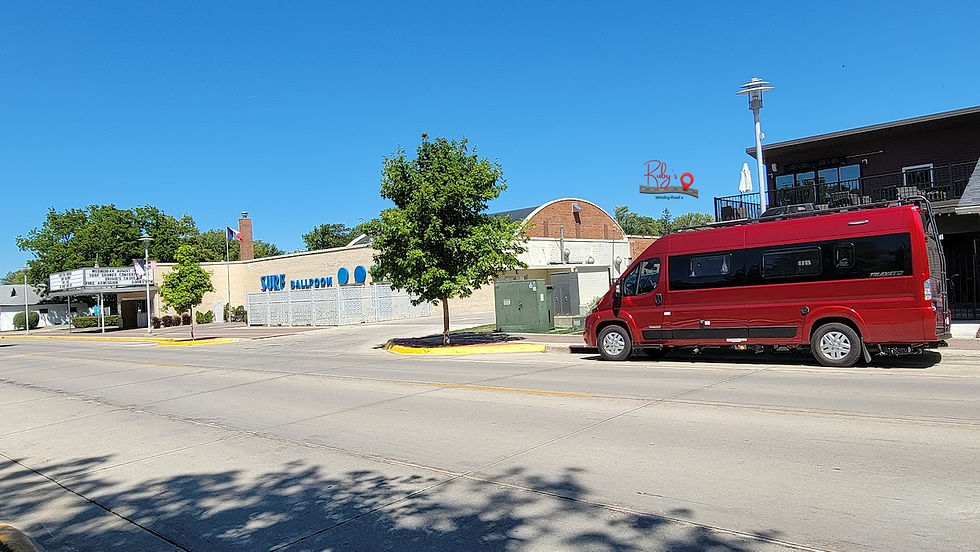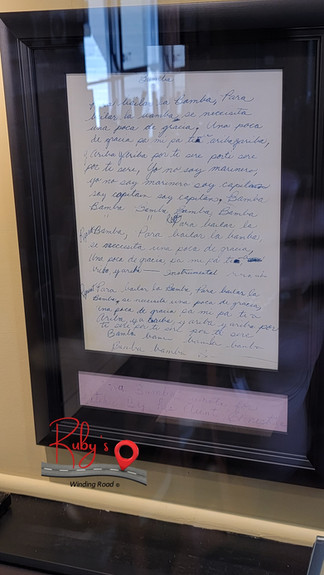Surfing for Music Legends in Clear Lake, Iowa
- Ruby's Winding Road

- Oct 8, 2023
- 8 min read
We stood on a mowed strip of green grass about a quarter mile from the roadside. There were rows of corn growing to one side of us and a soybean field on the other. Puffy white clouds danced in the blue sky overhead to the rustling sounds of swaying corn. Occasionally, we'd hear muffled voices of two or three people approaching us as we stood in the middle of this Iowa farm field. We were only miles from the town of Clear Lake.
There wasn't much going on along this rural stretch of roadway other than farming. When we'd hear the crunching sounds of gravel coming from under the tires of approaching cars and trucks, it was easy to suspect folks were arriving to pay tribute to four young men whose lives came to a tragic end out here on a winter night in February 1959.

Rock 'n' roll legends Buddy Holly, J.P. "The Big Bopper" Richardson, and Ritchie Valens had finished a show at the Surf Ballroom in Clear Lake before boarding a private plane headed to Fargo, North Dakota. Holly had chartered the plane to bypass a ride on an old and rundown bus being used during a 24-city regional Winter Dance Party Tour. The musicians had already suffered multiple bus mishaps including mechanical breakdowns, lack of heat and continuous bus replacements. Valens and Richardson were said to be ill and the frigid February temperatures and long drives were adding to their misery. A quick flight on a small chartered plane to an airport near their next show seemed a reasonable solution.
The three men and the plane's pilot, Roger Peterson, died only seven miles from their departure location when the plane crashed in this field and came to rest against a fence row. The Civil Aeronautics Board determined the cause, in part, was pilot disorientation. It was learned the pilot hadn't received the latest weather briefings that called for deteriorating weather conditions. He also had not qualified to fly by relying only on the use of the plane's instrumentation in low visibility conditions.
Holly is known for songs such as Peggy Sue and That'll Be The Day. Valens performed La Bamba and the ballad Donna. The snappy rhyming tune Chantilly Lace was charismatically sung by Richardson. With a steady trickle of people to the memorial site the day we visited, it seems fans still maintain interest in these songs, the artists who performed them and the crash many refer to as "the day the music died," as memorialized in Don McLean's 1971 song American Pie.
The memorial site is located on private property at the intersection of Gull Avenue and 315th Street. Guests are asked to be respectful during their visits. At the roadside near the T-intersection is a large pair of black-rimmed glasses in recognition of those worn by Holly. The sculpture lets motorists know they've reached the area of the crash.
We arrived mid morning and saw a few cars parked across the road in a very small gravel lot highlighted by a Don McLean banner. A lightpost in the parking area was topped with a red, white and blue guitar. A sign near it directed visitors to park in the lot. We were able to maneuver our Class B camper van in the lot, which also contained another van, a Class C motorhome, a car and a truck. There was space left for just a few more vehicles. However, it was good that people were quick to visit and leave due to the limited parking.
We made our way on foot across the gravel road toward the large pair of Buddy Holly glasses. Hanging from the sculpture were multiple pairs of sunglasses gifted by visitors. More were piled on the ground. As we arrived, people were writing heartfelt tributes on the legs of the sculpture with a Sharpie pen. There were dozens of signatures and messages scribbled. We were offered use of the pen, but declined. The pen, however, was left there for anyone else who felt the need to leave a message.
People were quietly taking selfies with the big pair of glasses or offering to take photos for others. A selfie tripod sat on the ground in front of the large eyeglasses for anyone who wanted to use it. Who did it belong to? Not sure. Who would steal it? Nobody here. That's not what people do at this site. Then, a few at a time, visitors took a quarter-mile walk into the field along the fence row to the actual location of the crash and memorial.
At first, we planned to only check out the pair of giant eyeglasses and then continue on our way to another destination. A walk into the field was not on the agenda for the day. It seemed... well... weird. But, there's something compelling about taking that journey into the field once you've arrived. Curiosity? A little bit. Moreover, it was something deeper. Maybe it was a realization about the fragility of life. So, like the others, we made our way to the area where the plane wreckage had been found all those years ago on a snowy day in February.

Rather than fighting the pilgrimage of curious fans, the caretaker of this area has carefully mowed a section of land large enough for people to quietly visit. The tall corn has a way of obscuring views and muffling outside sounds ensuring the small metal memorial in the shape of a guitar and three records is the sole focus for guests. A second metal marker in the shape of wings is in place to remember the plane's pilot.

"Gone too soon," someone wrote on a note left at the site. There were more sunglasses, flowers, guitar picks and additional notes. Some notes were scribbled on paper for all to read. Others were tightly folded or sealed and placed at the markers bearing the names of the men.

Other than the metal markers and mementos, little seems to have changed about the site from the time of the crash. It's still a farm field. It still has a fence row.
An original and yellowed newspaper reporting the crash to its readers in 1959, the Mason City Globe-Gazette, is on display at the Surf Ballroom in Clear Lake. "Rock 'n' Roll Idols Among Lake Crash Dead," reads the headline.
The newspaper details the ugly crash and includes photos of the mangled plane just after it had been discovered resting on the fence row. Grim photos on the front page are complete with arrows showing the location of the crash victims. Admittedly, these photos are hard to unsee once seen. Many visiting the memorial in this quiet field may not fully realize they are standing where the bodies of Holly and Valens came to rest after being ejected from the plane. Richardson, according to the article, was found across the fence row in front of the wreckage. The pilot remained entangled within the plane wreckage. A very sad ending for these young and talented individuals. Gone too soon but not forgotten. Indeed.
Our visit to the site of the crash came after our visit to the Surf Ballroom and Museum. It was at the ballroom that we'd learn more details about the three musicians final hours. The Surf Ballroom on N. Shore Drive is open to the public most days, but it really didn't look like it was open upon our arrival. No cars were around outside and the lights inside appeared dimmed.

A quick check of the door and it opened to an entry area just behind the ticket booth. John waited outside with the pup, while I (Kristin) ventured inside. A sign over the grand wooden doors let me know the Surf has a current capacity of 2,100 people. I opened those second set of doors, flanked by palms on each side, and entered into the lobby. The decor in the lobby makes you realize this building has its own story to tell. There's a stale smell of cigarettes mixed with "old" that reassures you've arrived to a building with a great amount of history. It's clear from first entry that thousands of people have made their way through the doors of the Surf Ballroom to dance to the music of hundreds of musicians.
To the left was a coat check area. It's $1 per checked coat according to the postings. To the left is a baby grand piano with badly chipped keys. A sign on the keyboard indicates the piano has been used by "countless musicians" during the Surf's history. Pretty sure that's true based upon its beat up and battered condition. Duke Ellington is said to have signed the underside of the top board. Closer inspection reveals the words, "The Duke" on the underside of the lid.
Initially, I didn't see anyone inside the Surf, but heard the voices of staff hollering back and forth somewhere deep in the building. I continued on until I found a table with a stack of Walking Tour and Exhibit Guide brochures. I picked one up. There was also a guest book. I signed it. There was a box to place a $5 admission fee (suggested donation). I honored the honor system. Someone finally spotted me, but didn't say anything. I continued to look around.
Hundreds of photos cover the walls of the Surf Ballroom and many are autographed. Fans of Buddy Holly and Ritchie Valens can view a phone booth in the lobby, complete with a rotary phone said to have been used by the pair just before they left the Surf on the evening of Feb. 2, 1959. Ornately designed carpeting created to resemble an earlier pattern covers terra cotta-colored floor tiles in the lobby. Pineapple stenciling discovered and restored from days gone by covers walls leading to the main venue area. It's in that main venue area that you'll find the main stage and roomy beach club booth seating surrounding a maple dance floor. I decided to sit in a few of the booths for a minute or two. I also took a quick spin on the dance floor. You know the old saying, "Dance like nobody's watching." So... I did.
The Surf Ballroom is a treat to visit as long as you take your time to really look at and read the museum displays. The current facility opened in 1948 after the original venue, built in 1933 across the street, burned in 1947. There are pictures of the original facility on display. The Surf was closed briefly in 1994 until it was purchased by the current owner and received needed restoration work.
The Surf Ballroom's entertainment history includes decades of musical headliners from the Big Band era to current country musicians and rock 'n' rollers. The museum contents reflect that history.

Visitors can check out the Green Room used by decades of performers and the Cypress Room loaded with musical memorabilia. You can linger as long as you'd like to do so to view an autographed B.B. King guitar, an autographed Peter Frampton guitar, a fiddle played by Charlie Daniels, and hundreds of photographs of people who have performed at this venue. You can also lean about the Winter Dance Party Tour featuring Holly, Valens and Richardson and view memorabilia that once belonged to each of the three men.
As mentioned, the Surf Ballroom asks for a small $5 donation to view the facility. It seems a reasonable request for a place listed on the National Register of Historic Places. There are pamphlets available to help with your self-guided tour. Guided tours are available by appointment and there is a small gift shop. There are also directions to the crash site memorial just outside of town. Having your own jam? The Surf can be rented for private events. Pretty neat considering the building is recognized as landmark by the Rock and Roll Hall of Fame. The hosts here are volunteers according to the pamphlet and are happy to answer questions. Hmmm. I wasn't approached by anyone while here. Rather, they let me take my time to linger about the facility. I was actually okay with that.
In addition to the historic Surf Ballroom, Clear Lake is a neat place. The town is located on the large Clear Lake in northern Iowa halfway between Des Moines and Minneapolis, Minnesota. The town has a beach feel with a variety of fish ready to be caught in its 3,684-acre lake. Walleye, Yellow Bass, Crappies and Flathead Catfish (just to name a few) are waiting to grab onto a fishing line, so bring your rod and reel. On our visit we found a number of folks enjoying the lake or riding bikes. We stayed at the Clear Lake State Park Campground for one night. It was a quick visit for us, but a good one. We'll stop back again.
Thanks for checking out our blog. Tap the heart button at the bottom of the page and share this post with friends. We've been out traveling so be sure to subscribe so you don't miss a post. To read about some of our past adventures visit RubysWindingRoad.com. Take care.
















































Comments